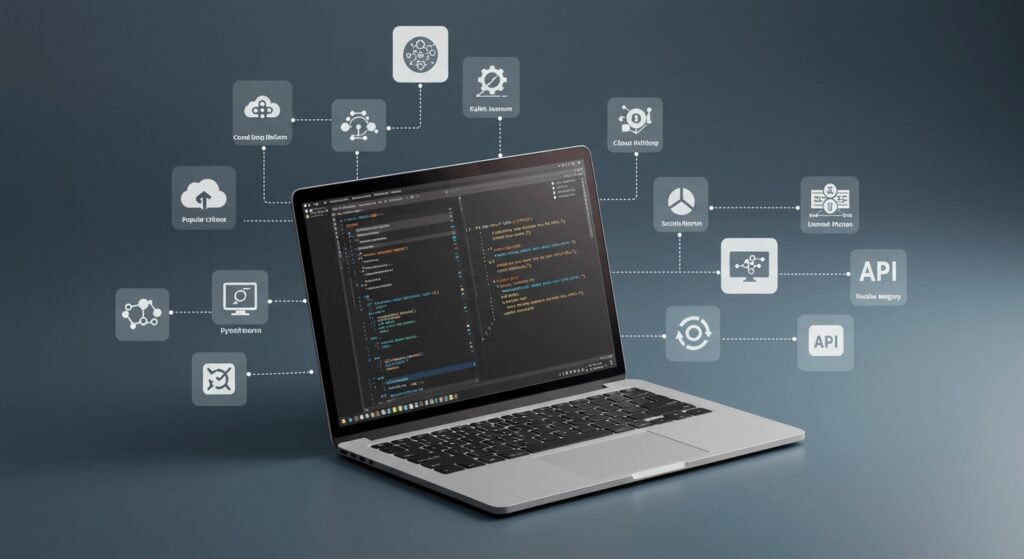Understanding AI & Machine Learning for Small Businesses
Artificial Intelligence (AI) and Machine Learning (ML) are no longer just futuristic concepts reserved for tech giants. Today, they are becoming powerful tools for small businesses, helping them automate tasks, gain insights from data, and improve customer experiences. But before diving into AI-powered solutions, it’s crucial to understand what these technologies are and how they work in a business setting.
What is Artificial Intelligence (AI)?
At its core, Artificial Intelligence (AI) refers to machines or software that can perform tasks typically requiring human intelligence. These tasks include learning, reasoning, problem-solving, and decision-making. AI systems are designed to analyze data, recognize patterns, and make informed predictions or recommendations.
For small businesses, AI can be seen in everyday tools like chatbots, automated customer service, smart marketing campaigns, and recommendation engines.
Types of AI Relevant to Small Businesses
- Reactive AI – AI that responds to specific inputs but doesn’t learn from past data (e.g., rule-based chatbots).
- Machine Learning AI – AI that improves over time by learning from data (e.g., predictive analytics).
- Generative AI – AI that creates new content, such as text, images, or videos (e.g., ChatGPT, MidJourney).
What is Machine Learning (ML)?
Machine Learning (ML) is a subset of AI that allows computers to learn from data without explicit programming. Instead of following rigid rules, ML algorithms analyze historical data to find patterns and make decisions or predictions.
For example, an e-commerce business using ML can automatically recommend products based on customer behavior and purchase history.
Types of Machine Learning Used in Small Businesses
- Supervised Learning – The AI learns from labeled data (e.g., email spam detection).
- Unsupervised Learning – The AI finds patterns in unlabeled data (e.g., customer segmentation).
- Reinforcement Learning – The AI improves by receiving feedback from actions (e.g., self-improving chatbots).
How AI & ML Differ from Traditional Software
Traditional software relies on predefined rules and logic—it does exactly what it’s programmed to do. AI & ML, on the other hand, learn and improve over time, making them far more flexible and powerful.
| Feature | Traditional Software | AI & Machine Learning |
|---|---|---|
| Predefined Rules | Fixed logic, no learning | Learns from data and adapts |
| Decision-Making | Based on coded instructions | Predicts based on past data |
| Human Involvement | High maintenance, manual updates | Automates and improves over time |
| Example Use Case | Simple accounting software | AI-powered expense tracking |
For small businesses, this means AI can automate repetitive tasks, reduce errors, and enhance decision-making without constant manual intervention.
Why Small Businesses Should Care About AI & ML
AI and ML are no longer just for big corporations with massive budgets. Today, even small businesses can leverage AI-driven tools to compete effectively. Here’s how:
- Save Time & Automate Tasks – AI can handle repetitive work like responding to emails, scheduling appointments, or managing inventory.
- Improve Customer Experience – Chatbots and virtual assistants can provide 24/7 customer support.
- Increase Sales with Data-Driven Insights – AI can analyze customer behavior to suggest the right products or services.
- Enhance Marketing Strategies – AI-powered marketing tools can personalize campaigns and optimize ad spending.
- Reduce Costs – AI-driven automation lowers operational expenses by eliminating unnecessary manual work.
Essential AI & Machine Learning Libraries & Tools for Small Businesses

Small businesses don’t need a team of data scientists to leverage AI & Machine Learning. Thanks to user-friendly libraries and no-code/low-code AI tools, companies can automate processes, gain insights, and enhance customer experiences with minimal technical expertise.
In this section, we’ll explore some of the most powerful and accessible AI & ML tools that small businesses can use today.
No-Code & Low-Code AI Tools (Best for Non-Technical Users)
For small businesses that don’t have an in-house AI development team, no-code and low-code AI tools make it easy to implement AI-powered solutions without writing a single line of code.
| Tool | Use Case | Key Benefits |
|---|---|---|
| Google AutoML | Image recognition, text analysis, and predictions | Drag-and-drop AI model training |
| Microsoft AI Builder | AI-driven automation for business apps | Seamless integration with Microsoft 365 |
| H2O.ai | Predictive analytics and customer insights | AI-powered decision-making for businesses |
| MonkeyLearn | Text analysis and sentiment tracking | Easy integration with marketing tools |
| ChatGPT & OpenAI API | AI chatbots, content generation | Automates customer interactions and content |
These platforms allow small businesses to automate marketing, enhance customer support, and improve decision-making without needing deep technical expertise.
Popular Machine Learning Libraries (Best for Tech-Savvy Users & Developers)
For businesses with some coding expertise, open-source ML libraries offer powerful tools for building AI-driven applications.
| Library | Best For | Key Features |
|---|---|---|
| TensorFlow | Deep learning, AI-powered applications | Google-backed, scalable, powerful |
| PyTorch | Image and speech recognition | Flexible, great for research & production |
| Scikit-Learn | Predictive modeling, data analysis | Simple, efficient ML algorithms |
| XGBoost | Sales forecasting, fraud detection | Fast and optimized for tabular data |
| NLTK & SpaCy | Chatbots, sentiment analysis | Natural Language Processing (NLP) |
If your business deals with data-driven decision-making, personalized recommendations, or predictive analytics, these libraries can help build custom AI applications.
AI-Powered Cloud Services (Best for Scalable & On-Demand AI)
Cloud-based AI services allow small businesses to leverage powerful AI capabilities without expensive infrastructure. These platforms provide ready-to-use AI models that can be integrated into existing applications.
| Cloud AI Service | Best Use Case | Why It’s Useful? |
|---|---|---|
| AWS AI & ML | Chatbots, image recognition, fraud detection | Scalable AI with pay-as-you-go pricing |
| Google Cloud AI | NLP, vision, recommendation engines | Pre-trained AI models for business use |
| IBM Watson AI | AI-powered automation, customer service | Industry-specific AI solutions |
| Azure AI | Document processing, analytics | Deep integration with Microsoft products |
These platforms reduce costs and complexity while offering advanced AI capabilities to businesses of all sizes.
AI Tools for Specific Business Needs
Depending on your business goals, here are some AI tools that cater to specific small business needs:
AI for Marketing & Sales
- HubSpot AI – Automates email marketing, lead scoring, and customer insights
- Persado – Uses AI to generate high-converting marketing copy
- Phrasee – AI-driven subject line and ad copy optimization
AI for Customer Support
- Drift – AI-powered chatbot for lead generation
- Zendesk AI – Automated ticket handling and customer support
- Tidio AI – AI chatbots to handle FAQs and online inquiries
AI for Finance & Operations
- QuickBooks AI – Smart financial management and expense tracking
- Kabbage – AI-driven small business loan analysis
- Xero AI – Automated invoicing and bookkeeping
How to Choose the Right AI Tool for Your Business
With so many options available, selecting the right AI tool depends on your specific business needs. Here’s how to decide:
- Identify Your Business Challenges – Do you need AI for marketing, sales, operations, or automation?
- Choose Between No-Code & Developer Tools – If you lack tech expertise, opt for no-code AI platforms.
- Consider Cost & Scalability – Start with free trials and scalable pricing models.
- Look for Easy Integrations – AI tools that work with your existing software (CRM, e-commerce, etc.) save time.
- Test & Measure ROI – Track improvements in efficiency, sales, or customer engagement to justify the investment.
How Small Businesses Can Implement AI & Machine Learning

AI & ML can help small businesses automate tasks, improve efficiency, and enhance customer experiences without requiring deep technical expertise. Here’s how to get started:
Identify Business Needs
Pinpoint areas where AI can add value, such as:
- Customer Service: AI chatbots (e.g., Drift, Tidio)
- Marketing & Sales: AI-driven email campaigns (e.g., HubSpot AI)
- Finance & Accounting: Automated bookkeeping (e.g., QuickBooks AI)
Choose the Right AI Tools
Pick AI solutions that fit your business:
- No-Code AI: Easy-to-use tools for automation
- Cloud AI Services: Scalable solutions (e.g., Google Cloud AI)
- ML Libraries: For tech-savvy teams (e.g., TensorFlow, Scikit-Learn)
Start Small & Test AI
Begin with low-risk AI projects, such as:
- Automated customer inquiries via chatbots
- AI-driven email personalization for marketing
- AI-powered sales forecasting
Integrate AI with Existing Systems
Ensure AI works smoothly with your CRM, e-commerce, and finance tools for easy adoption.
Train Employees & Optimize
Educate your team on AI tools and track key performance indicators (KPIs) like efficiency, sales growth, and cost savings.
Monitor & Adjust
Measure AI performance and refine your strategy for better results.
Conclusion & Next Steps
AI & Machine Learning are no longer just for big corporations—small businesses can now leverage AI to automate tasks, boost efficiency, and improve customer experiences with minimal investment. By identifying the right areas for AI adoption, choosing user-friendly tools, and integrating AI into daily operations, businesses can save time, reduce costs, and stay competitive. To get our AI and ML services you can visit this page.
Next Steps to Implement AI in Your Business:
- Start Small: Choose one AI-driven tool or process to test.
- Automate Smartly: Focus on areas like customer service, marketing, and finance.
- Train Your Team: Ensure employees understand and effectively use AI tools.
- Monitor & Optimize: Track AI’s impact and adjust strategies for better results.
The future belongs to businesses that embrace AI. Start today and unlock new growth opportunities!






0 Comments